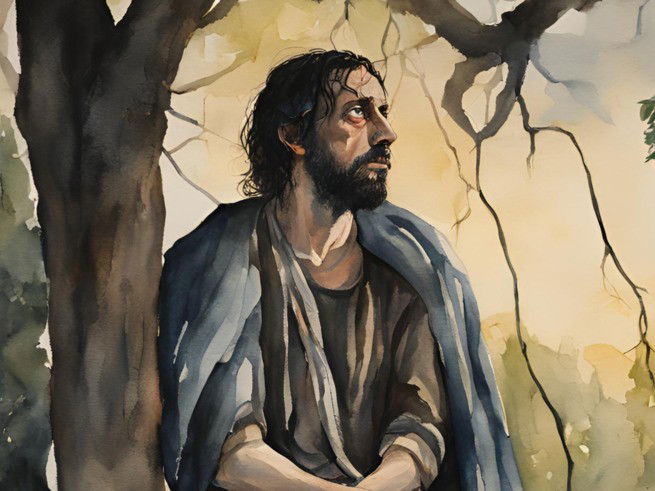Judas Iscariot was one of the twelve disciples of Christ, known for betraying Jesus in exchange for 30 pieces of silver. After leading the soldiers to the place where Jesus was, Judas handed Him over with a kiss. His betrayal serves as a reminder of the danger of greed and human weakness in the face of temptation.
Jesus called Judas Iscariot to follow Him. His name “Iscariot” refers to a town called Kerioth in Judea, distinguishing him from the other apostles, who were mostly from Galilee.
Judas lived in a period of intense political and religious upheaval, where the Jews were under the rule of the Roman Empire. Many expected the Messiah to be a leader who would liberate them politically. Judas Iscariot, like the other apostles, believed that Jesus would promote a revolution. However, Jesus came to liberate humanity from sin and announce the kingdom of God.

Judas' behavior was marked by traits of ambition and greed. He was chosen to be the treasurer, responsible for managing the apostles' money. However, the Gospel of John mentions that Judas was dishonest and stole from the common treasury, indicating a tendency toward corruption.
Judas met Jesus at the beginning of His ministry and, like the other disciples, was a witness to His miracles and teachings. Despite living so close to the Master, it seems that his vision of Jesus' mission began to drift away from reality. It is possible that Judas expected Jesus to lead a revolt against the Romans.
Judas' betrayal is the episode that made him notorious. According to the Gospels, he agreed to betray Jesus for thirty pieces of silver and led the Roman soldiers to the Garden of Gethsemane, where Jesus was praying. Judas identified Jesus with a kiss, thus sealing his betrayal.
Judas' end was tragic. After seeing Jesus condemned to death, he felt remorse and tried to return the silver coins to the priests, but was refused. Desperate and overwhelmed by guilt, Judas hanged himself, ending his story in a dark way.
Judas Iscariot is remembered as a symbol of betrayal and disloyalty. His story warns us about the dangers of excessive ambition and greed, and also shows the consequences of choosing the wrong path, even after living so close to the truth.
Main Events in the Life of Judas Iscariot
- Jesus called Judas: Judas was chosen by Jesus as one of the twelve apostles, and thus he accompanied Jesus during His ministry.
- Thief Treasurer: Judas was assigned the task of managing the apostles' money, being responsible for the bag where the money was kept. As treasurer, the Gospel of John recounts that Judas stole from the common purse.
- Planned Betrayal: Judas made a deal with the religious leaders to betray Jesus in exchange for thirty pieces of silver.
- The Last Supper: During the Last Supper, Jesus announced that He would be betrayed and identified Judas as the traitor.
- Judas handed over Jesus to the Romans: Judas led the soldiers to Jesus in the Garden of Gethsemane and identified Him with a kiss, thus confirming His identity.
- Late repentance: After Jesus' arrest, Judas attempted to return the money to the priests, feeling remorse for what he had done, but was refused, leading him to fall into despair.
- Death of Judas: Desperate and consumed by guilt, Judas went and hanged himself. In the Book of Acts, it is recounted that he fell and his body was torn to pieces.
What We Can Learn from the Life of Judas Iscariot
The life of Judas Iscariot offers important lessons about character, choices, and the consequences of spiritually closing oneself off to God. Although Judas was chosen as one of the twelve apostles and lived closely with Jesus, he chose a path that led to his ruin. His example warns us about the dangers of greed, lack of integrity, and resistance to God's true purpose.
One of the clearest lessons his story teaches is about the risk of allowing the love of money to corrupt our values. Judas, who was responsible for the group's finances, often stole from the common purse. This greed culminated in his betrayal, when he accepted thirty pieces of silver in exchange for handing Jesus over to His persecutors. His choice exemplifies how the pursuit of material goods can lead a person away from their principles.

Another lesson is related to spiritual disillusionment. Judas, like many at the time, may have followed Jesus with the hope that He would establish a political kingdom and bring liberation from Rome. Realizing that Jesus came to announce the Kingdom of God and not a political revolution, Judas may have become disillusioned, seeking an escape through betrayal. This alerts us to the danger of projecting our personal expectations onto God and not accepting His greater plan.
The story of Judas also teaches us about repentance. Although Judas felt remorse after betraying Jesus, his despair led him to suicide instead of seeking forgiveness. This shows us the importance of acknowledging our mistakes and seeking redemption rather than letting guilt consume us.
Judas' example serves as a warning about the consequences of bad decisions and the importance of keeping a pure heart before God.
Bible Study on Judas Iscariot
The Betrayal of Judas Iscariot
During the Last Supper, when Jesus shared the meal with His twelve apostles before His arrest, He revealed that one of them would betray Him. The disciples were perplexed, unsure of whom Jesus was speaking about. Then, Jesus indicated that the traitor would be the one to whom He would give the piece of bread dipped in the dish (John 13:26). When He handed the bread to Judas, he took it, and at that moment, Satan entered him. Jesus then said to Judas, "What you are about to do, do quickly." This revealed Judas' identity as the betrayer.
Judas' betrayal was carried out in the Garden of Gethsemane, just as he had agreed with the religious leaders to deliver Jesus for thirty pieces of silver. On the night of the betrayal, Judas led the guards to the place where Jesus usually prayed with His disciples. To identify Him among the group, Judas gave Him a kiss, a common greeting gesture at the time, but which, in that moment, signaled to the soldiers who they should arrest.
The reasons why Judas betrayed Jesus are not entirely clear, but several interpretations exist. One possibility is that Judas was motivated by greed, as he accepted money to carry out the betrayal. Another theory is that Judas, like many at the time, expected Jesus to be a political leader who would free Israel from Roman rule. Regardless of the exact reasons, Judas' betrayal had consequences that led to Jesus' arrest, trial, and crucifixion.
The Corrupt Character of Judas Iscariot
The Bible does not say what Judas Iscariot's profession was before he became one of Jesus' twelve apostles. However, during his time as a disciple, Judas worked as the treasurer, responsible for managing the money shared among the apostles. Unfortunately, he frequently stole from the treasury.
One event that revealed Judas' character was his reaction of indignation when Mary of Bethany broke an expensive jar of perfume and poured it on Jesus' feet. He criticized the act, claiming that the perfume could have been sold to donate the money to the poor. Judas' criticism was dishonest, as he did not care for the poor and often stole from the treasury.
Judas Iscariot's dishonest behavior, marked by greed and corruption, culminated in the bribery of thirty pieces of silver. He betrayed Jesus by handing Him over to the religious leaders in exchange for money.
The Calling of Judas Iscariot to Jesus (Or Did He Volunteer Himself?)
Many question whether Judas was called or if he volunteered, but the Bible says that Judas Iscariot was called by Jesus to be one of His apostles, just like the other disciples. The Bible does not mention that Judas offered himself to follow Jesus and be His disciple.
In the Gospel of Luke, it is stated that Jesus spent a night in prayer before choosing the twelve apostles, including Judas among them. Therefore, Jesus directly called him to be part of the group of disciples, even though He knew that Judas would eventually betray Him.
Read more The Calling of the Apostles: How Jesus Chose the Twelve Disciples.
How Judas Iscariot Died
What happened to Judas Iscariot was tragic. After betraying Jesus for thirty pieces of silver, Judas was overcome with remorse. In the Gospel of Matthew, it is said that, upon seeing Jesus condemned, Judas repented and tried to return the money to the religious leaders. However, they did not accept it. In desperation, Judas threw the coins into the temple and went to hang himself.
However, there is another account in the book of Acts (Acts 1:18) narrated by Peter, which describes Judas' death in more detail. Peter states that Judas purchased a field with the money from the betrayal and there he fell face down, split open and all his entrails spilled out.
Although the accounts seem to diverge, many scholars believe that the two complement each other. One possible interpretation is that Judas hanged himself, as described in Matthew, and then his body fell and broke into pieces, as narrated in Acts. This second event may have occurred after the rope broke or after his body decomposed.
Judas' death reflects his torment and the tragic consequences of his betrayal. He, who was so close to Jesus, eventually fell into greed and remorse, leading to a desperate end. His story is a grim reminder of the weight of bad choices and the search for redemption.
Learn about other biblical characters and their stories:
